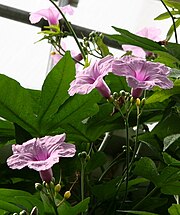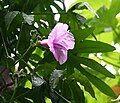Ipomoea mauritiana
| Ipomoea mauritiana subsp. var. | giant potato | |||||||||||||||||||||||||||||||||||||||||||||||||||||||
|---|---|---|---|---|---|---|---|---|---|---|---|---|---|---|---|---|---|---|---|---|---|---|---|---|---|---|---|---|---|---|---|---|---|---|---|---|---|---|---|---|---|---|---|---|---|---|---|---|---|---|---|---|---|---|---|---|

|
|
| ||||||||||||||||||||||||||||||||||||||||||||||||||||||
| ||||||||||||||||||||||||||||||||||||||||||||||||||||||||
The giant potato (Ipomoea mauritiana) is a type of morning glory plant. Like the sweet potato, it belongs to the Ipomoea genus. It grows as a vine.
| Standard Cyclopedia of Horticulture |
|---|
|
Ipomoea digitata, Linn. (I. paniculata, R. Br. I. palmata, Hort., not Forsk.). St. trailing or climbing, 20-40 ft.: lvs. 3-7 in. wide, 5-7-parted, the segms. elliptic, sometimes spatulate, entire: fls. numerous, in a 2-branched cyme; corolla l ½ -3 in. wide, broadly bell-shaped, 5-lobed, pinkish purple or pink: seeds with a dense tuft of dirty white wool springing from the apex. July-Sept. Tropics of both hemispheres.—One of the best tuberous-rooted ipomoeas for the garden or warm- house. In the N. it may be used with fine effect if grown in a tub and trained to an adjacent pillar or trellis, the vine being cut off before frost and the tub stored. Farther south the tubers may be planted directly in the open, and will give a profusion of bloom nearly all summer. var. insignis, Hort. (I. insignis, Ker). Lvs. not palmately divided, nearly entire or lobed, the under surface sometimes purplish. —There are few plants of var. insignis in cult.
|
Cultivation
Propagation
Pests and diseases
Varieties
Gallery
References
- Standard Cyclopedia of Horticulture, by L. H. Bailey, MacMillan Co., 1963
External links
- w:Ipomoea mauritiana. Some of the material on this page may be from Wikipedia, under the Creative Commons license.
- Ipomoea mauritiana QR Code (Size 50, 100, 200, 500)


